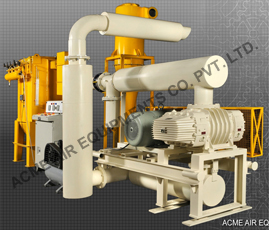Table of Contents
A Dust Collection System is an essential piece of industrial equipment to ensure the quality of air and safety of an environment. It is an effective method of removing particles from an air source using a simple formula. It consists of three parts: capture, convey, and collect. This article will provide an overview of dust collection systems and their components. You will also be able to learn about the types of dust collectors available and what regulations they follow.
What are Dust collection System Components?
There are many parts of a dust collection system. The most important component is the dust collector itself. The collector catches and removes airborne particles, which can be harmful to the respiratory system of occupants. Additionally, most dust is combustible, which means that special handling is necessary. For this reason, there are options to choose the dust collector for your specific needs, such as explosion-prevention vents and suppression vents. No return isolation valves are also available for safety.
The static pressure in inches of water is the best measurement of the power and size of the dust collector. You should draw a floor plan for your shop and mark where the dust ports should be. Make sure to mark the size of the machines and the floor-to-joist measurement so you know where to place the dust ports. You should also mark the best duct routing for the dust collectors and consider the number of turns. The CFM or airflow rate of the system components is an important factor when choosing the ducting system.
What are Different Types of Dust Collectors?
There are many different types of dust collectors available on the market. Some of them have a single stage that collects airborne dust particles. Single-stage dust collectors don’t typically have a powerful motor. These types of collectors are most suitable for smaller spaces and have less powerful filters. They also require frequent filter replacement. If you’re concerned about fire safety, you may want to consider a wet dust collector, which uses water to collect the dust.
The most common type of industrial dust collector is the baghouse. This type is efficient at capturing and filtering high-density particles. They take up more space than other types of dust collectors and are often placed outdoors. They’re useful in woodworking, agriculture, food processing, pharmaceuticals, and recycling. Pulse jet dust collectors are also great for pneumatic conveying and size reduction. And because of their low noise level, they’re the best choice for many industrial applications.

What are Safety Considerations for Dust Collectors?
There are several safety considerations to take when using a dust collection system. For example, the system should be properly maintained and equipped to handle hazardous dust. These safety features prevent workers from accidentally opening the doors during the pulsing cycle of the collector and exposing them to hazardous dust. An additional safety precaution is to install a bag-in/bag-out containment system to keep used filters separate from employees.
Another important safety consideration is to determine the composition of the dust being collected. Almost all materials will burn in dust form if the correct proportions are present, but this depends on the material. Therefore, facility personnel should collect the necessary information about the materials that are used in their work. Safety professionals must also be aware of any potential fire hazards caused by combustible dust.
What are Regulations for Dust Collection Systems?
The regulations for dust collection systems have strict requirements for ventilation, air volume, and ducts. A proper ventilation system should meet the minimum air velocity requirements for combustible dust. A dust collector should also meet minimum air volume requirements. A dust collector must be equipped with isolation devices to prevent the spread of explosions. The hood of the dust collector must achieve the minimum air velocity required for combustible dust collection. The airflow must be documented based on the design of the system and branch ducts must remain connected to each other.
What is the Cost of a Dust Collection System?
If you are looking to save money on your air pollution, one option to consider is purchasing a dust collection system. Although the initial cost of such a system is higher than that of a typical HVAC system, long-term savings can be worth the cost. Many systems can accommodate up to four different machines simultaneously. Depending on the amount of equipment you will need to clean, this system may be an excellent choice for your business.
The cost of a dust collection system depends on many factors, including the size of the system, the number of filters, the fan capacity and the temperature of operation. In addition, certain special components may be required for the best filtration of oils, moisture, harsh chemicals and other highly abrasive materials, which will add to the overall price. Ultimately, the cost of a dust collection system will help you protect your most valuable assets and increase the productivity of your business.
The Bottom Line
Before they can land on surfaces, harmful dust and gases from the air are collected by an industry dust collector. To safeguard your personnel and remain in accordance with key governing agencies, most facilities utilise dust collectors to control pollution and odours during processing and production processes. Now that you are aware of the many factors involved in buying an industrial dust collector, it is time to make a purchase. Each sort of dust collecting system is available in a variety of sizes, is made for specific purposes, and may be enhanced with unique characteristics to function as effectively as possible. Last but not least, you would like an industrial dust collecting system that lowers the expense of equipment downtime while fostering a cleaner and better working atmosphere.



